Author: Alexander Maxfield Arnosky
School/Organization:
AMY Northwest
Year: 2015
Seminar: Penn Laboratory on Energy, Sustainability and Environment
Grade Level: 6-8
Keywords: being “the other”, ethics, science fiction, social commentary, time travel
School Subject(s): Math
There is no sense of urgency to save our environment. This is largely due to an uneducated populace that cannot see past tomorrow, or simply does not care to. This unit is designed to educate young people about the impending energy crisis and to make it undeniably relevant.
If everyone on the planet lived like an American, we would need five Earths. Even though we only make up approximately five percent of the population, we consume twenty percent of the energy produced and, more incredibly, we produce forty percent of the global waste. Most of us are privy or have at least heard about the catastrophes on the horizon: global warming, rising tides, intensified and increased floods and droughts, and a litany of other disasters that could quite possibly eliminate the human race. What can we do to alleviate some of the many stresses we are placing on the Earth? This unit, geared towards middle school children, is designed to raise awareness about waste and promote an enduring lifestyle of sustainability.
Download Unit: Arnosky-Alexander-unit.pdf
Did you try this unit in your classroom? Give us your feedback here.
There is no sense of urgency to save our environment. This is largely due to an uneducated populace that cannot see past tomorrow, or simply does not care to. By educating young people about the impending environmental crisis and making it undeniably relevant we can ensure a future for our kids. As a middle school educator in the city, I have become somewhat an authority on waste. Schools in the School District of Philadelphia do not recycle. Every day there are trashcans full of bottles, cans, and paper—all of which are headed right to the landfill. Not only are we not recycling glass, aluminum, and paper products, we are wasting food. An inordinate amount of uneaten food finds its way to the trash every day and in every school. This sets a bad precedent for students and faculty members. Students spend one third of their lives in school. They see the waste around them, but there seems to be no sense of urgency or dedicated actions taken by those in charge to remediate this waste. This is an opportunity for educators to engage students in the conversation about sustainability and its importance. Using the classroom as our think-tank, we can: create a space where we analyze the environmental problems that surround us, understand that this model cannot and should not continue, and ultimately develop a plan to remedy the current situation and deal with problems that may arise in the future. The detrimental effects of living such a wasteful lifestyle are not immediate. When a child throws away his/her prepackaged hamburger lunch without even opening it, he/she is wasting thousands of gallons of water. The manner in which beef is raised is heavily dependent on water—a resource that has become more and more scarce within the past decade. Factoring into account the amount of water needed to grow the hay or grain to feed the cattle, we estimate it takes 12,000 gallons of water to produce 1 pound of beef. In comparison, a pound of potatoes and a pound of corn require 60 gallons and 168 gallons to cultivate respectively. The Water Conservation activity of this unit is designed to put our everyday water consumption into perspective and to create a dialog about the alternatives to beef that are both healthier for our bodies, and the planet. Some may consider coal to be an antiquated fuel that is representative of a more primitive America. However, nearly 40% of our electricity comes from the combustion of coal. Coal burning plants account for the majority of CO2 emissions, a greenhouse gas that is the leading contributor to global warming. While coal and the electricity we get from coal is relatively cheap, the long-term effects are certain to be disastrous and expensive. Along with CO2, the process of burning coal produces a litany of harmful chemicals including lead and mercury that are either housed in landfills or dispersed into the air. A Better Bulb teaches students about the importance of efficiency and looks at simple, cost effective ways to make our homes more eco-friendly and sustainable. Columbite-Tantalum is a metallic ore mined mainly in Africa. Refined, “Coltan” becomes essential in creating capacitors which are present in almost all modern electronics. There is a disconnect between our actions as individuals and the impact they may have on our planet. As educators, we are in a prime position to weave the importance of sustainability into all disciplines. Throughout the Blood Coltan portion of the unit, we will look at the economic, social, and ethical ramifications of mining and consuming this highly sought after ore. Using project based learning and requiring that students be reflective in their decision-making, we can create a classroom of conservationists who will continue their eco-friendly practices outside of the classroom. The more informed people, children in particular, we have involved in the conversation, the better chance we have of affecting change on a larger scale. With rising temperatures and increased frequency of natural disasters, only recently have we heard the call for a more modest lifestyle for the sake of our planet and our children. This unit forces the issue and challenges students to assess and scrutinize our wasteful habits. This kind of environmental awareness is rarely taught in middle school and students who opt not to take environmental science in high school may never get the opportunity to learn about eco-friendly choices and the catastrophic consequences that accompany a society bereft of environmental awareness. This unit ultimately leads students to the question, “Why should I care about this?” Professor Beth Conklin of Vanderbilt University addresses the issue of teaching children the importance of sustainability. To that end, she references the “Precautionary Principle” as one of her primary teaching tips. In essence, the principle tells us that if we are making choices or performing actions that could potentially be harmful to others, the burden of proof, then, is on us to prove that these choices and actions are not harmful. It teaches students about making responsible decisions even though they may not know or understand the magnitude of the consequences of their actions. It requires serious critical thought and reflection. This is the philosophical and ethical strand that runs throughout the unit. All activities and discussions are designed to enable students to understand that the choices they make do matter and they must realize that their actions have immediate and, more importantly, long-term consequences for themselves and the planet.
My goal is to create a unit replete with real experiences that forces students to take a look at the decaying world around them. Students will realize that there are limitations to our resources and that it is important to conserve and sustain these resources. Ideally, students will work towards developing a conservationist attitude that will persist throughout their lives and inform their future decisions. With this unit, we will examine projections, models, and the mathematics behind exponential growth, rates of change, and correlation in order to build on and strengthen students’ knowledge of algebraic fundamentals in accordance with Pennsylvania’s Common Core State Standards and the Algebra I Keystone exam. At the completion of this unit:
Sustainability and relevance are inseparable. The underlying strategy of this unit is to make every lecture, discussion, and classroom activity relevant and meaningful to the student. By doing this, the information conveyed has a much better chance of remaining with the child and influencing his/her environmental choices in the future. The teacher is tasked with continually guiding the unit and the importance of sustainability back to the everyday life of each person in the classroom. Another strategy that is more of a social construct that needs to be established at the beginning of the unit is a sense of community and belonging. Students have to feel as though they are part of something larger than themselves. Whether it be extrapolating data and realizing the vastness of our waste or simply thinking about a boy or girl halfway around the world who is literally living in their waste, every activity in this unit forces students to take a step back and look at the bigger picture.
Water Conservation One of the most precious resources we have is water. We rarely think about how much we waste or the calamitous consequences that would accompany a water shortage. In this activity I encourage students to keep a water journal in which they would log their usage (i.e. washing hands, showering, flushing the toilet, etc). We will then compile these results and extrapolate our findings to get a better sense of how much water we use as a class, school, community and city. We will also examine how much a difference we can make if we all just reduce our consumption by a modicum. Day One Note: Prior to this lesson, teachers should create a short presentation outlining how we use water in the United States. Presentations should include but not be limited to agriculture, mining, and domestic use. Students will be placed in small groups and asked to create a list of everything their families do on a monthly basis that requires water. Students will then research the amount of water used in each of these activities. Students will record their families’ water consumption using the water log (see appendix) over the next 7 days. Day Two When students reconvene they will review their data and be asked to predict how much water their family will use in a month and how much they will use in a year. Day Three Students will compile their data and determine how much water they are using as a class. Additional calculations and discussion questions will follow (see appendix). Day Four Students will research ways to conserve water and create posters to hang in their school hallways to raise awareness and promote a culture of conservation within the school. A Better Bulb It is hard to justify spending $19 on a single light bulb. But what if that light bulb lasted longer, was cheaper to operate, and was just as bright as a bulb one quarter the price—would it be worth it? This activity is designed to turn students into conscious, eco-friendly, consumers. Students will be asked to compare several comparable flood lights to see which one is the “best buy” after 10 years of use. This activity will focus on y-intercepts, intersections, and slope. It will also bring to the foreground the relationship between efficiency and a lower energy bill. Day One The teacher will review what a kilowatt-hour is as well as its cost in the current market. Day Two Students will go online to the home improvement store of their choosing to research different types of light bulbs that will be used to light up the main hall of their homes. Students will then calculate what each bulb will cost to operate for the year based on a usage rate of 5 hours/day. Day Three Students will graph time vs. cost for each of their light bulbs. Day Four The class will discuss which bulbs are the better buy as well as review the components of each graph. Critical Questions include: What do the intersections mean? How do the slopes of the graphs differ? How could we present our findings in order to affect change? Blood Coltan There seems to be a lack of social accountability when it comes to conservation and recycling. This stems from poor education on the subject and the fact that students have little to no (readily perceived) incentives to conserve. Taking a look at consumption and the true cost of our electronics will undoubtedly spark a conversation that will hopefully lead to understanding and ultimately action. Day One Note: Prior to this lesson, teachers should create several knotted balls of string (1 per student). Knotted balls should be approximately the size of golf balls and will have one distinctive color (the Coltan) running through the maze of string. Students will be given a menial task in order to simulate the labor-intensive act of extracting precious metals from electronics. They will be given several knotted balls of string and instructed to undo each knot by hand and set three strands of Coltan aside before they are permitted to go to lunch. Students cannot speak to one another and if they do, they will receive another ball of knotted string. Before breaking for the day, the students will reflect on the experience. The discussion should be student centered. The teacher may also direct the conversation by asking guiding questions such as: “Why do you think I had you do this?” and “How did this activity make you feel?” Day Two Students will watch portions of the documentary Blood Coltan. As they watch, students will be asked to complete an accompanying questionnaire. Allow 10-15 minutes for students to complete the questionnaire (see appendix). The teacher will lead a discussion about the social and ethical implications of the movie and what we can do as a class to reduce our dependency on such precious metals. Day Three Students will be asked to abstain from all cell phone usage for one day. Students will keep an hour-by-hour journal and tally every time they thought about going to their cell phones. Students will use a histogram to graph their potential usage results. Students will discuss the “importance” of their devices to their world. Students will be asked, “What would you be willing to do now to ensure continued use of your devices for you and generations to come?” Could Your Lunch Power Your Home? Students will examine the relationship between calories (kcal) burned and energy and determine if they could potentially generate enough power (energy) to run a portion of their home. This activity also lends itself to (eco)-friendly competition. Day One Students will be asked to download any number of calorie tracking devices to their smart phones. The teacher will provide students with all necessary energy conversions and challenge them to calculate the number of kilocalories (the calories we gain from food) required to produce one kilowatt-hour. Students will begin tracking their movement and will keep a running log of the calories burned. For homework, students will research the energy consumption of several common household appliances and record them (see appendix). They will also record (nightly) how long each appliance was in operation to later determine how many kilowatt-hours of energy were needed in order to power their home for one day. Day Two Using what they’ve learned about kilowatts and kilowatt-hours, students will calculate the total number of kilowatt-hours required to power their homes for a given day. Students will tabulate their families’ total energy consumption and cost based on the market rate for a kilowatt-hour. Students will continue to monitor their activity and total calories burned. Day Three After two days of logging their activity and monitoring the number of calories burned, students will convert their calories to kilowatt-hours using the conversion: 1kilowatt-hour = 860 kcal. The student that “powered” the greatest percentage of his/her home will be crowned the King/Queen of Conservation. The teacher will then direct students to complete the conservation handout and after 15-20 minutes will discuss students’ reactions and responses to this activity (see appendix).
Water Conservation Activity Sheets A Better Bulb Activity Sheets Blood Coltan Activity Sheets Could Your Lunch Power Your Home? Activity Sheets 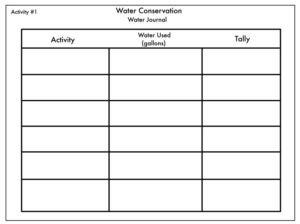
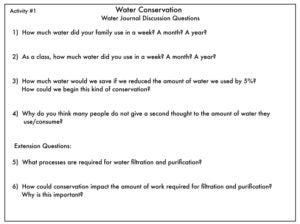
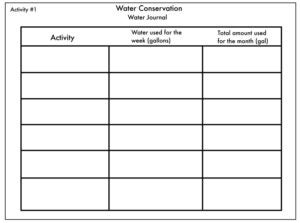
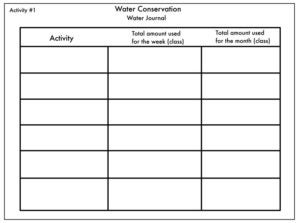
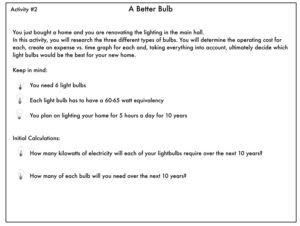
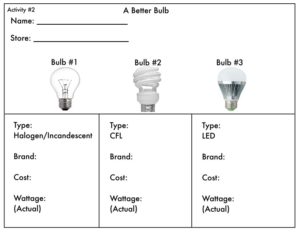
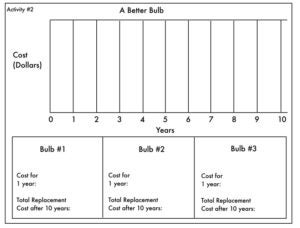
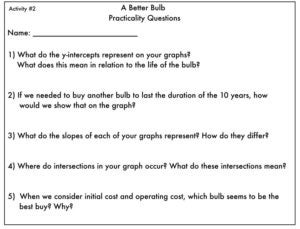
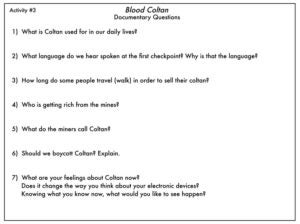
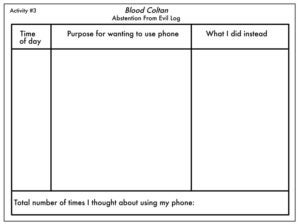
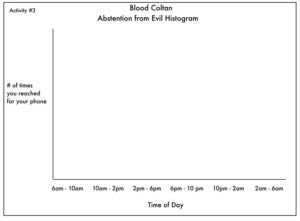
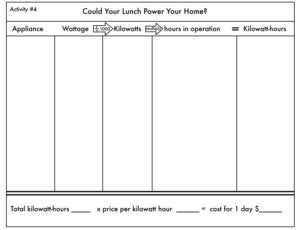
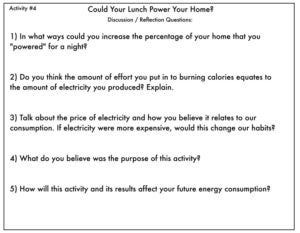
Anthony, Sebastian. “Will Your Body Be the Battery of the Future? | ExtremeTech.” ExtremeTech. N.p., 5 Sept. 2012. Web. 23 Apr. 2015. This article explores the possibility of using our bodies as the next potential breakthrough in producing and capturing energy. It talks about the limitations and where the field of wearable computers is headed. “Blood Coltan.” Top Documentary Films RSS. Top Documentary Flims, 2007. Web. 11 Apr. 2015. The documentary “Blood Coltan” sheds light on the powerful international interests protecting this blood trade. Meet the powerful warlords who enslave local population and the European businessmen who continue importing Coltan, in defiance of the UN. “Calculators and Converters.” Financial Calculators and Metric Conversions. ARGH Industries Ltd., n.d. Web. 22 Mar. 2015. This website allows students to convert between several different types of units. This should be used not as a shortcut for determining the initial conversions, rather, a time saver after dimensional analysis becomes second nature and a complete understanding of conversions has been established. Conkilin, Beth. “Tips for Teaching Sustainability.” CFT RSS. Vanderbilt University, n.d. Web. 22 June 2015. <http://cft.vanderbilt.edu/guides-sub-pages/sustainability/>. Anthropologist Beth Conklin from Vanderbilt University offers eight teaching strategies for teaching sustainability to children. Many of these strategies could be seamlessly incorporated into this or any unit on sustainability. Delawala, Imtiyaz. “What Is Coltan?” ABC News. ABC News Network, n.d. Web. 22 Feb. 2015. abc News provides a rudimentary guide to Coltan—what it is, why we need it, and the ethical quagmire in which we find ourselves as such great consumers of the mineral. Duffy, Jill. “The 25 Best Fitness Apps.” PCMAG. N.p., 3 June 2015. Web. 9 June 2015. This is a PC Mag article that reviews and ranks the top 25 fitness applications for Apple and Android devices. Students can peruse the article, noting key differences among apps and which one would best suit them for their fourth activity: Could My Lunch Power My Home? Elert, Emily. “Daily Infographic: If Everyone Lived Like An American, How Many Earths Would We Need?” Popular Science. N.p., 19 Oct. 2012. Web. 5 June 2015. In this blog for Popular Science the author looks at the gluttonous lifestyles of Americans and asks the question, “If everyone lived like an American, how many Earths would we need?” This blog shows perspective in a simple way that is sure to be the spark for many conversations through out the unit. “EPA WaterSense | Water Efficiency, Water Conservation & Water Savings.” EPA. Environmental Protection Agency, n.d. Web. 3 Apr. 2015. The Environmental Protection Agency’s partnership with WaterSense offers people simple ways to use less water with water-efficient products, new homes, and services. The website also has a kids friendly sub-division as well as water saving calculator and many ideas on how you can do your part to conserve. “How Coal Works.” Union of Concerned Scientists. N.p., n.d. Web. 26 June 2015. This site details the process of refining coal so it can be burned safely and transformed into the energy we use every day. It also provides statistics about coal reserves and talks about the environmental impacts of increased coal production. “Instructional Tools.” Instructional Tools. N.p., n.d. Web. 22 June 2015. <http://ecoliteracy.org/teach/instructional-tools>. This website provides teachers with lessons, activities, and discussion guides pertaining to sustainability. The site focuses on the interdisciplinary nature of sustainability and how to incorporate the issue into all curricula. Pimentel, David, and Marcia Pimentel. Food, Energy, and Society. Niwot, Co.: U of Colorado, 1996. Print. This book brings to light the unsustainable livestock production model we currently have in the United States and the delicate balance between humans, animals and crops that is becoming less and less stable. Reese, April. “July/August 2015.” Discover Magazine. N.p., 28 May 2015. Web. 1 June 2015. This article from a recent issue of Discover Magazine focuses on emissions, the increase in natural disasters due to record atmospheric levels of carbon, and what we are doing to reduce emissions and our dependency on coal and oil. “U.S. Energy Information Administration – EIA – Independent Statistics and Analysis.” U.S. Energy Information Administration (EIA). N.p., n.d. Web. 21 June 2015. This independent website provides statistics on production, reserves, and distribution for all of the fuels we use as a country. You can also browse energy consumption surveys for the residential, commercial, and industrial sectors.
8th Grade Common Core Standards that will be addressed include: